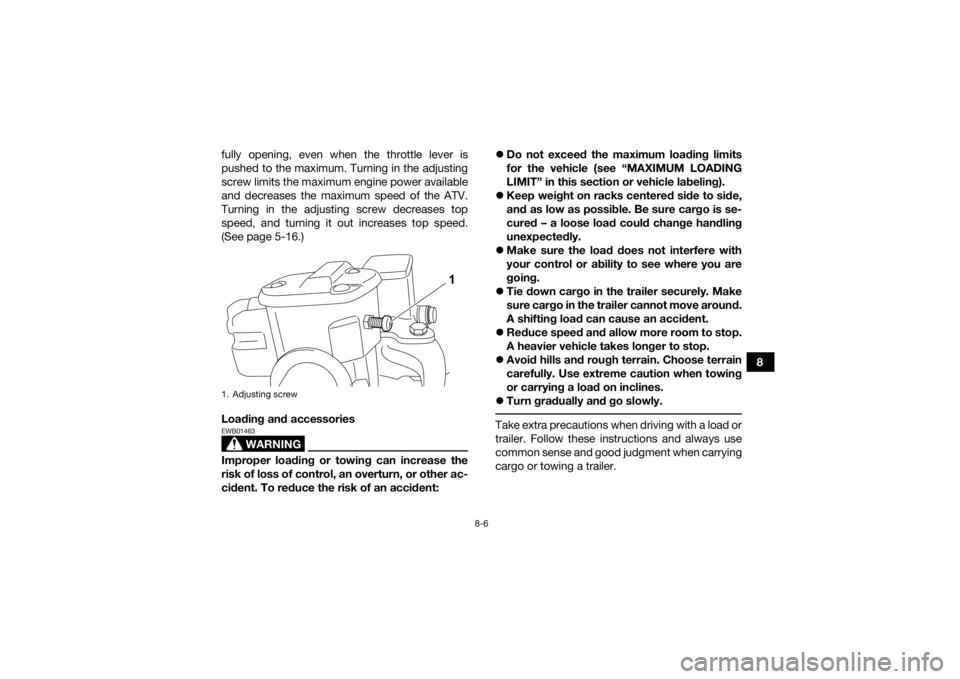trailer YAMAHA GRIZZLY 700 2022 Owners Manual
[x] Cancel search | Manufacturer: YAMAHA, Model Year: 2022, Model line: GRIZZLY 700, Model: YAMAHA GRIZZLY 700 2022Pages: 176, PDF Size: 4.75 MB
Page 8 of 176

EBU17421
TABLE OF CONTENTS
VEHICLE IDENTIFICATION ............................ 1-1Identification numbers ................................ 1-1
LOCATION OF THE WARNING AND
SPECIFICATION LABELS .............................. 2-1
SAFETY INFORMATION ................................ 3-1
DESCRIPTION................................................ 4-1 Left view ...................................................... 4-1
Right view.................................................... 4-1
Controls and instruments............................ 4-2
INSTRUMENT AND CONTROL
FUNCTIONS ................................................... 5-1 Main switch ................................................. 5-1
Indicator lights and warning lights .............. 5-2
Multi-function display ................................. 5-5
Handlebar switches .................................. 5-11
Throttle lever ............................................. 5-16
Speed limiter ............................................. 5-16
Front brake lever ....................................... 5-17
Brake pedal and rear brake lever .............. 5-17
Drive select lever ....................................... 5-18 Fuel tank cap ............................................ 5-19
Fuel ........................................................... 5-20
Seat .......................................................... 5-21
Storage compartments ............................. 5-22
Front carrier .............................................. 5-26
Rear carrier ............................................... 5-26
Front and rear shock absorbers .............. 5-26
Winch ....................................................... 5-28
Trailer hitch .............................................. 5-28
Auxiliary DC jack....................................... 5-29
PRE-OPERATION CHECKS .......................... 6-1 Fuel ............................................................. 6-4
Engine oil .................................................... 6-4
Final gear oil ............................................... 6-4
Differential gear oil ...................................... 6-4
Coolant ....................................................... 6-4
Front and rear brakes ................................. 6-4
Throttle lever ............................................... 6-5
Tires ............................................................ 6-5
Chassis fasteners ....................................... 6-8
Instruments, lights and switches ................ 6-8UBLT60E0.book Page 1 Tuesday, July 13, 2021 9:16 AM
Page 21 of 176

2-9
2
E10E5
**.* kPa
*.** kgf/cm²
*.* psi **.* kPa
*.** kgf/cm²
*.* psi
YAMAHA MOTOR CO., LTD.
2500 SHINGAI, IWATA, JAPAN
******
*** kW
*** kg
****1
2
34 This pictogram shows trailer Hitch Tow
weight limit. (Combined weight of the trailer
and all cargo in the trailer.)
Overloading can cause loss of control.
Loss of control can result in severe injury or
death.
EN228 fuel identification mark.
Gasoline of ethanol 10% or less can be
used. EN228 fuel identification mark.
Gasoline of ethanol 5% or less can be used.
Use unleaded gasoline only.
Measure the tire pressure when the tires are
cold. Adjust the tire pressure.
Improper tire pressure can cause loss of
control.
Loss of control can result in severe injury or
death.
This pictogram shows the loading limits
and/or maximum load capacity for this ATV.
Follow all load limits and other loading
guidelines in this manual.
Load may include the driver, passenger,
human protective gear, accessories, goods,
luggage, and all other load related items.
Make sure you do not exceed the load limits.
Overloading can cause loss of control.
Loss of control can result in severe injury or
death.
This pictogram shows trailer Hitch Tongue
weight limit. (Weight on the trailer tongue.)
Overloading can cause loss of control.
Loss of control can result in severe injury or
death.
1
2
3
4 Year of construction
Model Name
Max. Power
Mass In Running Order
UBLT60E0.book Page 9 Tuesday, July 13, 2021 9:16 AM
Page 24 of 176

3-3
3technique described in this manual on level
ground. Avoid crossing the side of a steep hill if
possible.
Always use proper procedures if you stall or roll
backwards when climbing a hill. To avoid stall-
ing, use the proper gear range and maintain a
steady speed when climbing a hill. If you stall or
roll backwards, follow the special procedure for
braking described in this manual. Dismount on
the uphill side or to a side if pointed straight up-
hill. Turn the ATV around and remount, following
the procedure described in this manual.
Always check for obstacles before operating in
a new area.
Never attempt to operate over large obstacles,
such as large rocks or fallen trees. Always follow
proper procedures when operating over obsta-
cles as described in this manual.
Always be careful when skidding or sliding.
Learn to safely control skidding or sliding by
practicing at low speeds and on level, smooth
terrain. On extremely slippery surfaces, such as
ice, go slowly and be very cautious in order to
reduce the chance of skidding or sliding out of
control.
Never operate an ATV in fast flowing water or in
water deeper than that recommended in this
manual. Remember that wet brakes may have
reduced stopping ability. Test your brakes after
leaving water. If necessary, apply them several
times to let friction dry out the linings.
Always be sure there are no obstacles or people
behind you when you operate in reverse. When
it is safe to proceed in reverse, go slowly.
Always use the size and type of tires specified in
this manual.
Always maintain proper tire pressure as de-
scribed in this manual.
Never exceed the stated load capacity for an
ATV. Cargo should be properly distributed and
securely attached. Reduce speed and follow in-
structions in this manual for carrying cargo or
pulling a trailer. Allow greater distance for brak-
ing.
Do not operate your ATV during darkness un-
less it is equipped with a properly functioning
headlight. Off-road riding is inherently danger-
ous and additionally, off-road trails do not have
streetlights to guide you.
UBLT60E0.book Page 3 Tuesday, July 13, 2021 9:16 AM
Page 57 of 176

5-28
5
EBU39230Winch
WARNING
EWB04350To reduce the risk of injury or death, read and
follow the Winch Owner’s Manual prior to use.
Never let anyone come between the winch and
pulled object or the winch and anchor point.
Do not use the winch unless all bystanders area safe distance away. Use hook strap to keep
hands away from fairlead when winding the
winch rope.
NOTICEECBM0051Prolonged winching can overheat the winch
motor and can drain the vehicle’s battery, even
when the engine is idling. Allow the winch mo-
tor to cool and the battery to recharge between
uses. EBU28972Trailer hitch This ATV is equipped with a 5 cm (2 in) trailer hitch
receiver.
Trailer towing equipment can be obtained at a
Yamaha dealer. (See page 7-6 for precaution in- formation.)
1. Winch
2. Hook
3. Hook strap
4. Fairlead
1
3
2
4
UBLT60E0.book Page 28 Tuesday, July 13, 2021 9:16 AM
Page 58 of 176

5-29
5
EBU19187Auxiliary DC jackNOTICEECB03760Do not use any single electrical accessory or
combination of accessories that require more
than the stated capacity at any one time. This
may overload the circuit and cause the fuse to
blow.
1. Trailer hitch receiver
1
1. Auxiliary DC jack cap
2. Auxiliary DC jackAuxiliary DC jack system capacity:8.0 A (96 W)
21
UBLT60E0.book Page 29 Tuesday, July 13, 2021 9:16 AM
Page 65 of 176

6-6
6
Tire pressure must be checked and set when the
tires are cold. The tire pressure should be the
same on both sides, and must be adjusted ac-
cording to vehicle loading conditions. Set the tire
pressure as specified below.
WARNING! Opera-
tion of this vehicle with improper tire pressure
may cause severe injury or death from loss of
control or rollover. Tire pressure below the
minimum specified could also cause the tire to
dislodge from the rim under severe driving
conditions.
[EWB04120]
OPERATING TIRE PRESSURE (cold):
No cargo or trailer: Front: (Recommended)35.0 kPa (0.350 kgf/cm², 5.0 psi)
Rear: (Recommended) 30.0 kPa (0.300 kgf/cm², 4.4 psi) (BLT5,
BLT8)
35.0 kPa (0.350 kgf/cm², 5.0 psi) (BLTE)
Front: (Minimum) 32.0 kPa (0.320 kgf/cm², 4.6 psi)
Rear: (Minimum) 27.0 kPa (0.270 kgf/cm², 4.0 psi) (BLT5,
BLT8)
32.0 kPa (0.320 kgf/cm², 4.6 psi) (BLTE)
With cargo or trailer: Front: (Recommended)50.0 kPa (0.500 kgf/cm², 7.3 psi)
Rear: (Recommended) 50.0 kPa (0.500 kgf/cm², 7.3 psi)
Front: (Minimum) 45.0 kPa (0.450 kgf/cm², 6.5 psi)
Rear: (Minimum) 45.0 kPa (0.450 kgf/cm², 6.5 psi)
UBLT60E0.book Page 6 Tuesday, July 13, 2021 9:16 AM
Page 66 of 176

6-7
6Tire inspection
When the tire tread depth has worn to 3 mm (0.12
in) replace the tire. If the tire has a nail or glass
fragments in it, or if the sidewall is cracked, re-
place the tire. Tire information
This ATV is equipped with tubeless tires and tire
air valves. After extensive tests, only the tires list-
ed below are approved for this model by Yamaha.
WARNING
EWB02552Use of improper tires on this ATV may cause
loss of control, increasing your risk of an acci-
dent.
Maximum load:
Ve h i cl e :240.0 kg (530 lb)
The vehicle’s maximum load is the com-
bined weight of the rider, accessories, car-
go, and trailer tongue weight.1. Tire tread depthUBLT60E0.book Page 7 Tuesday, July 13, 2021 9:16 AM
Page 73 of 176

7-6
7
sold by Yamaha or modifications not specifically
recommended by Yamaha, even if sold and in-
stalled by a Yamaha dealer.
Aftermarket parts, accessories, and modifica-
tions
While you may find aftermarket products similar in
design and quality to genuine Yamaha Accesso-
ries, recognize that some aftermarket accessories
or modifications are not suitable because of po-
tential safety hazards to you or others. Installing
aftermarket products or having other modifica-
tions performed to your ATV that change any of
the vehicle’s design or operation characteristics
can put you and others at greater risk of serious
injury or death. You are responsible for injuries re-
lated to changes in the vehicle.
Keep the following in mind when considering an
accessory or operating an ATV which has acces-
sories.
Accessories should be rigidly and securely
mounted. An accessory which can shift position
or come off while you are riding could affect
your ability to control the ATV.
Do not mount an accessory where it could inter-
fere with your ability to control the ATV. Exam-
ples include (but are not limited to) a heavy or bulky object attached to the handlebars which
could make steering difficult, an accessory that
limits your ability to move around on the seat, or
one that limits your view.
Use extra caution when riding an ATV with ac-
cessories. The ATV may handle differently than
it does without accessories.
EBU34692Loading
WARNING
EWB00821Never exceed the stated load capacity for this
ATV. Overloading this ATV or carrying or tow-
ing cargo improperly could cause changes in
ATV handling which could lead to an accident.
Cargo should be properly distributed and se-
curely attached. Reduce speed when carrying
cargo or pulling a trailer. Allow greater dis-
tance for braking. Cargo or a trailer can change the stability and han-
dling of an ATV.
You must use common sense and good judgment
when carrying cargo or towing a trailer. Keep the
following points in mind:
UBLT60E0.book Page 6 Tuesday, July 13, 2021 9:16 AM
Page 74 of 176

7-7
7
Never exceed the weight limits shown. An over-
loaded ATV can be unstable.
Do not exceed the maximum tongue weight.
You can measure tongue weight with a bath-
room scale. Put the tongue of the loaded trailer
on the scale with the tongue at hitch height. Ad-
just the load in the trailer, if necessary, to reduce
the weight on the hitch. If you are carrying cargo
and towing a trailer, include the tongue weight
in the maximum ATV load limit.
Load cargo on the carriers as close to the center
of the ATV as possible. Put cargo at the rear of
the front carrier, at the front of the rear carrier,
and center it.
Tie down cargo securely to the carriers. Make
sure cargo in the trailer cannot move around. A
shifting load can cause an accident.
Make sure the load does not interfere with con-
trols or your ability to see where you are going.
Ride more slowly than you would without a
load. The more weight you carry, the slower you
should go. Although conditions vary, it is good
practice not to exceed low range whenever you
are carrying heavier loads or when towing a
trailer.
Allow more braking distance. A heavier ATV
takes longer to stop.
MAXIMUM LOADING LIMIT
ATV loading limit (total weight of rider, car-
go, accessories, and tongue):240.0 kg (530 lb)
Front carrier: 50.0 kg (110 lb)
Rear carrier: 90.0 kg (198 lb)
Front storage compartment: 0.5 kg (1 lb)
Center storage compartment: 4.0 kg (9 lb)
Rear storage compartment: 2.0 kg (4 lb)
Trailer hitch: Pulling load (total weight of trailer and
cargo):5880 N (600 kgf, 1322 lbf)
Tongue weight (vertical weight on trailer
hitch point): 147 N (15 kgf, 33 lbf)
UBLT60E0.book Page 7 Tuesday, July 13, 2021 9:16 AM
Page 81 of 176

8-6
8
fully opening, even when the throttle lever is
pushed to the maximum. Turning in the adjusting
screw limits the maximum engine power available
and decreases the maximum speed of the ATV.
Turning in the adjusting screw decreases top
speed, and turning it out increases top speed.
(See page 5-16.)
Loading and accessories
WARNING
EWB01463Improper loading or towing can increase the
risk of loss of control, an overturn, or other ac-
cident. To reduce the risk of an accident:
Do not exceed the maximum loading limits
for the vehicle (see “MAXIMUM LOADING
LIMIT” in this section or vehicle labeling).
Keep weight on racks centered side to side,
and as low as possible. Be sure cargo is se-
cured – a loose load could change handling
unexpectedly.
Make sure the load does not interfere with
your control or ability to see where you are
going.
Tie down cargo in the trailer securely. Make
sure cargo in the trailer cannot move around.
A shifting load can cause an accident.
Reduce speed and allow more room to stop.
A heavier vehicle takes longer to stop.
Avoid hills and rough terrain. Choose terrain
carefully. Use extreme caution when towing
or carrying a load on inclines.
Turn gradually and go slowly.
Take extra precautions when driving with a load or
trailer. Follow these instructions and always use
common sense and good judgment when carrying
cargo or towing a trailer.
1. Adjusting screw
1
UBLT60E0.book Page 6 Tuesday, July 13, 2021 9:16 AM